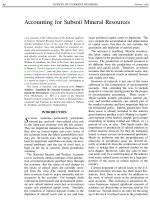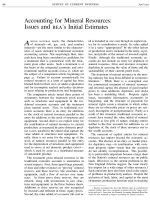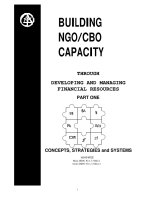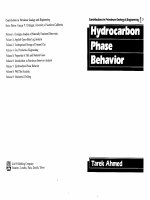Geology and nonrenewable mineral resources
Bạn đang xem bản rút gọn của tài liệu. Xem và tải ngay bản đầy đủ của tài liệu tại đây (4.38 MB, 46 trang )
Chapter 15
Geology and
Nonrenewable Mineral
Resources
Chapter Overview Questions
What major geologic processes occur within the earth and on its
surface?
What are nonrenewable mineral resources and where are they found?
What are rocks, and how are they recycled by the rock cycle?
How do we find and extract mineral resources from the earth’s crust, and
what harmful environmental effects result from removing and using
these minerals?
Chapter Overview Questions (cont’d)
Will there be enough nonrenewable mineral resources for future
generations?
Can we find substitutes for scarce nonrenewable mineral resources?
How can we shift to more sustainable use of nonrenewable mineral
resources?
Updates Online
The latest references for topics covered in this section can be found at
the book companion website. Log in to the book’s e-resources page at
www.thomsonedu.com to access InfoTrac articles.
InfoTrac: Residents discuss towns' deaths. Daily Oklahoman (Oklahoma
City, OK) August 2, 2006.
InfoTrac: All that glitters: the demand for gold is soaring. Jane Perlez,
Kirk Johnson. New York Times, May 8, 2006 v138 i14 p12(6) .
InfoTrac: In Old Mining Town, New Charges Over Asbestos. Kirk
Johnson. The New York Times, April 22, 2006 pA1(L).
Science Daily: Putting Coal Ash Back Into Mines A Viable Option For
Disposal, But Risks Must Be Addressed
National Park Service: Mining Operations Management
Arizona Mining Association: From the Ground Up: Mining/Mineral
Resource Development
Core Case Study: The
Nanotechnology Revolution
Nanotechnology uses science and engineering to create materials
out of atoms and molecules at the scale of less than 100
nanometers.
Little environmental harm:
• Does not use renewable resources.
Potential biological concerns.
• Can move through cell membranes:
Figure 15-1
GEOLOGIC PROCESSES
The earth is made up of a core, mantle, and crust and is constantly
changing as a result of processes taking place on and below its surface.
The earth’s interior consists of:
Core: innermost zone with solid inner core and
molten outer core that is extremely hot.
Mantle: solid rock with a rigid outer part
(asthenosphere) that is melted pliable rock.
Crust: Outermost zone which underlies the
continents.
GEOLOGIC PROCESSES
Major features of the earth’s crust and upper mantle.
Figure 15-2
Volcanoes
Abyssal
floor
Trench
Abyssal plain
Craton
lp
lai
n
Abyssal hills
Abyssal Oceanic
floor
ridge
Folded
mountain
belt
Ab
ys
sa
Oceanic crust
(lithosphere)
Mantle (li
thospher
e)
Continental
shelf
Continental
slope
Continental
rise
Continental crust (lithosphere)
Mantle (lithosphere)
Mantle (asthen
o
sphere)
Fig. 15-2, p. 336
Te
c
pl toni
at c
e
Collision between
two continents
to
c tec
i
n
a
Oce plate
nic Spreading Oceanic tecto
nic
center
plate
ement
v
o
m
Plate
Subduction
zone
Continental
crust
Oceanic
crust
Plate mov
em
Ocean
trench
ent
Oceanic
crust
Continental
crust
Material cools Cold dense
as it reaches material falls
the outer back through
mantle
mantle
Hot
Mantle
material
convection
rising
cell
through
the
mantle
Two plates move
towards each other.
One is subducted back
into the mantle on a
falling convection
current.
Mantle
Hot outer
core Inner
core
Fig. 15-3, p. 337
GEOLOGIC PROCESSES
Huge volumes of heated and molten rack moving around the earth’s
interior form massive solid plates that move extremely slowly across the
earth’s surface.
Tectonic plates: huge rigid plates that are
moved with convection cells or currents by
floating on magma or molten rock.
The Earth’s Major Tectonic Plates
Figure 15-4
The Earth’s Major Tectonic Plates
The extremely slow movements of these plates cause them to grind into
one another at convergent plate boundaries, move apart at divergent
plate boundaries and slide past at transform plate boundaries.
Figure 15-4
Fig. 15-4, p. 338
JUAN DE
FUCA PLATE
EURASIAN PLATE
NORTH
AMERICAN
PLATE
PACIFIC
PLATE
ANATOLIAN
PLATE
CARIBBEAN
PLATE
ARABIAN
AFRICAN PLATE
PLATE
SOUTH
AMERICAN
NAZCA PLATE
PLATE
SOMALIAN
SUBPLATE
CHINA
SUBPLATE
PHILIPPINE
PLATE
INDIAAUSTRALIAN
PLATE
ANTARCTIC PLATE
Divergent plate
boundaries
Convergent plate
boundaries
Transform
faults
Fig. 15-4a, p. 338
Trench
Volcanic island arc
Craton
Transform
fault
Su
bd
Lithosphere
Asthenosphere
Divergent plate boundaries
Lithosphere
uc
Rising
tio
n magma
zo
n
Asthenosphere e
Convergent plate boundaries
Lithosphere
Asthenosphere
Transform faults
Fig. 15-4b, p. 338
GEOLOGIC PROCESSES
The San Andreas Fault is
an example of a
transform fault.
Figure 15-5
Wearing Down and Building Up the
Earth’s Surface
Weathering is an
external process that
wears the earth’s
surface down.
Figure 15-6
Parent material
(rock)
Biological
weathering
(tree roots and
lichens)
Chemical
weathering
(water, acids,
and gases)
Particles of parent material
Physical weathering
(wind, rain, thermal
expansion and
contraction, water
freezing)
Fig. 15-6, p. 340
MINERALS, ROCKS, AND THE
ROCK CYCLE
The earth’s crust consists of solid inorganic elements and compounds
called minerals that can sometimes be used as resources.
Mineral resource: is a concentration of
naturally occurring material in or on the earth’s
crust that can be extracted and processed into
useful materials at an affordable cost.
General Classification of
Nonrenewable Mineral Resources
The U.S. Geological Survey classifies mineral resources into four major
categories:
Identified: known location, quantity, and quality
or existence known based on direct evidence and
measurements.
Undiscovered: potential supplies that are
assumed to exist.
Reserves: identified resources that can be
extracted profitably.
Other: undiscovered or identified resources not
classified as reserves
General Classification of
Nonrenewable Mineral Resources
Examples are fossil fuels
(coal, oil), metallic minerals
(copper, iron), and
nonmetallic minerals (sand,
gravel).
Figure 15-7
Reserves
Other
resources
Economical
Identified
Not economical
Decreasing cost of extraction
Undiscovered
Decreasing certainty
Existence
Known
Fig. 15-7, p. 341
GEOLOGIC PROCESSES
Deposits of nonrenewable mineral resources in the earth’s crust vary in
their abundance and distribution.
A very slow chemical cycle recycles three types of rock found in the
earth’s crust:
Sedimentary rock (sandstone, limestone).
Metamorphic rock (slate, marble, quartzite).
Igneous rock (granite, pumice, basalt).
Rock Cycle
Figure 15-8
Erosion
Transportation
Weathering
Deposition
Igneous
rock Granite,
pumice,
basalt
Sedimentar
y rock
Sandstone,
limestone
Heat,
pressure
Cooling
Heat, pressure,
stress
Magma
(molten rock)
Melting
Metamorphic rock
Slate, marble,
gneiss, quartzite
Fig. 15-8, p. 343









